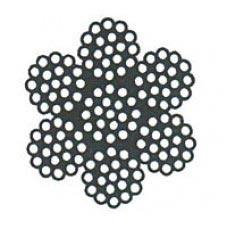Wire Ropes: Strong, Reliable, and Safe
 Wire ropes are designed to be strong, reliable, and safe. They consist of individual strands of numerous smaller wires twisted together, creating a helical structure. This construction provides wire ropes with excellent strength, flexibility, and resistance to abrasion. Wire ropes can deliver exceptional performance and reliability when maintained and inspected regularly.
Wire ropes are designed to be strong, reliable, and safe. They consist of individual strands of numerous smaller wires twisted together, creating a helical structure. This construction provides wire ropes with excellent strength, flexibility, and resistance to abrasion. Wire ropes can deliver exceptional performance and reliability when maintained and inspected regularly.
Common Issues Associated with Broken or Breaking Wire Ropes
Broken or breaking wire ropes can lead to a variety of issues, including:
- Safety hazards: Damaged wire ropes pose a significant risk to workers and the public. A sudden failure of a wire rope can result in falling loads or equipment collapse, leading to injuries or fatalities.
- Equipment damage: When a wire rope breaks, the sudden release of tension can cause damage to other components of the system, such as pulleys, winches, or the structure itself.
- Reduced efficiency: As wire ropes wear and break, their load-bearing capacity diminishes. This can force operators to reduce the weight of loads or take additional time to complete tasks, negatively impacting efficiency.
The Responsibility of Operators to Inspect Wire Ropes and Rigging Supplies
Operators must ensure the safety and reliability of wire ropes and rigging supplies by conducting regular inspections. These inspections should include the following:
- Understanding different wire rope types: Operators should be familiar with various wire rope types, such as the flexible and strong 6x25, 6x36, 35x7 construction, and know what to look for when inspecting each type.
- Visual inspection: Operators should visually inspect wire ropes for signs of wear, corrosion, or damage. This can identify issues before they become critical and require replacement.
- Physical inspection: Operators should also physically examine wire ropes, feeling for broken wires, kinks, or other abnormalities that may indicate a need for replacement.
- Inspecting rigging supplies: Operators must be aware of the status of their rigging supplies, ensuring they are in good condition. This includes checking for wear or damage on hooks, shackles, and other connecting components.
- Documentation: Keeping detailed records of wire rope inspections, maintenance, and replacements can help operators track the condition of their ropes and rigging supplies and ensure compliance with safety regulations.
By regularly inspecting wire ropes and rigging supplies and taking appropriate action when issues are identified, operators can minimize the risk of catastrophic failures and maintain the safety and efficiency of their operations.
Related Reading